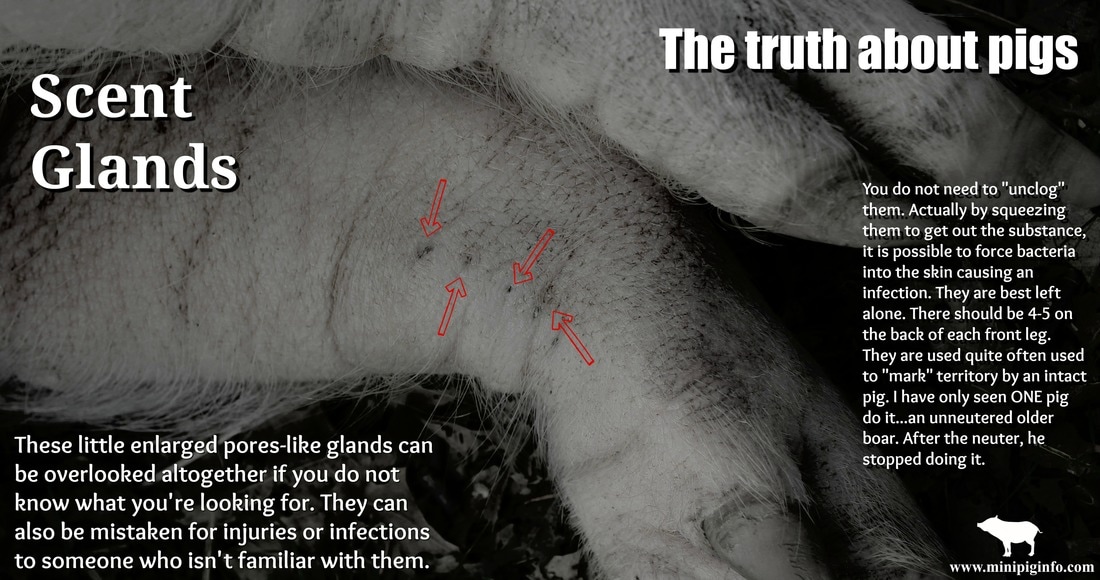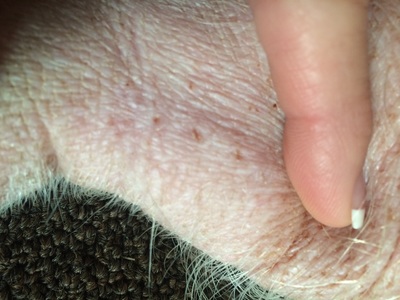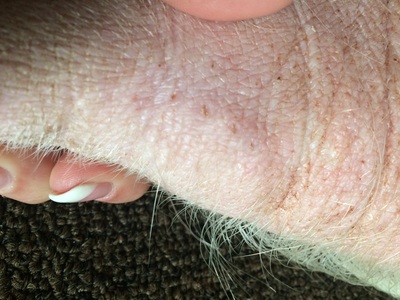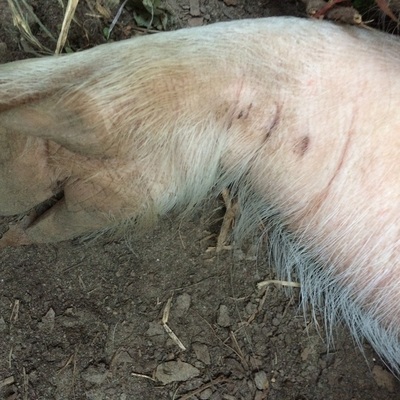Scent glands
These pictures below are scent glands (or the scientific name metacarpal glands)
I made the mistake, with my first pig, and called my vet immediately and told them there was some kind of worm or insect or skin infection that was eating hole in my piglets legs. My vet actually didn't know what they were either and gave me antibiotic spray and instructions to keep that area dry and clean....I did found out many months later what they actually were and can certainly understand how people would think that holes in the legs could be a big problem. But, please don't panic! They are on every pig and normal.
My suggestion? Just leave them alone. You can actually cause the area to become abscessed if you pick at it too much. There are usually 4-5 little "holes" on the backside of the front legs. Other glands they may have include; preorbital glands (around the eyes), perineal glands, mandible or mental glands (tusks or around the mouth) and preputial glands (around the corkscrew area-little boy parts). All of these secrete odorous compounds which may or may not function in actual scent marking. When a young boar is castrated early, sometimes the gland doesn't fully mature and the odor is never a problem in regards to the preputial gland, some vets remove this during the neuter. But sometimes this "pocket" collects fluids (urine and semen) and will swell up and possibly even have to be expressed every so often. This is unusual, but it does occasionally happen.
They tend to fill up with a substance, usually you can scrape it off with a fingernail or use the blunt end of tweezers to gently scrape and remove the contents, and to be honest, most pigs enjoy expressing of these glands. The substance is a thick white/light brown color and resembles a pus like material. It is some kind of compound made in their body, and it's normal. So, no need to rush off to the vet if you happen to see this area. If the area is red (and you haven't been picking at it), hot to the touch, and your pig has a fever, then you may want to call your vet or make an appointment, typically this area requires no attention and can be left alone. People with darker pigmented pigs may not even know they're there...but if you take your fingers and run them across the anterior part of the front legs, you may feel a couple little rough areas, if you look more closely, you may notice these glands. As I said, they don't usually cause any issues and do not need any attention, you do not need to express them and they're better off if you just leave them alone.
I made the mistake, with my first pig, and called my vet immediately and told them there was some kind of worm or insect or skin infection that was eating hole in my piglets legs. My vet actually didn't know what they were either and gave me antibiotic spray and instructions to keep that area dry and clean....I did found out many months later what they actually were and can certainly understand how people would think that holes in the legs could be a big problem. But, please don't panic! They are on every pig and normal.
My suggestion? Just leave them alone. You can actually cause the area to become abscessed if you pick at it too much. There are usually 4-5 little "holes" on the backside of the front legs. Other glands they may have include; preorbital glands (around the eyes), perineal glands, mandible or mental glands (tusks or around the mouth) and preputial glands (around the corkscrew area-little boy parts). All of these secrete odorous compounds which may or may not function in actual scent marking. When a young boar is castrated early, sometimes the gland doesn't fully mature and the odor is never a problem in regards to the preputial gland, some vets remove this during the neuter. But sometimes this "pocket" collects fluids (urine and semen) and will swell up and possibly even have to be expressed every so often. This is unusual, but it does occasionally happen.
They tend to fill up with a substance, usually you can scrape it off with a fingernail or use the blunt end of tweezers to gently scrape and remove the contents, and to be honest, most pigs enjoy expressing of these glands. The substance is a thick white/light brown color and resembles a pus like material. It is some kind of compound made in their body, and it's normal. So, no need to rush off to the vet if you happen to see this area. If the area is red (and you haven't been picking at it), hot to the touch, and your pig has a fever, then you may want to call your vet or make an appointment, typically this area requires no attention and can be left alone. People with darker pigmented pigs may not even know they're there...but if you take your fingers and run them across the anterior part of the front legs, you may feel a couple little rough areas, if you look more closely, you may notice these glands. As I said, they don't usually cause any issues and do not need any attention, you do not need to express them and they're better off if you just leave them alone.
These are all pictures of the same pig, same scent glands. Except the last two pictures. They are from a rescue boy and as you can see, his scent glands are much more pronounced. He also marked his territory often by getting closer to the ground on his front two legs and using these glands to put his smell on everything by kneading on things, sort of like a cat would do with their claws. These are located on the back of the front legs and sometimes look like a "skin tag" or a hole filled with a substance. You do NOT need to do anything with these. Some people pick at them and remove the contents, the gland will quickly fill back up again and they're better off if left alone.
There IS a scent gland of sorts on male pigs that female pigs do not have. This is called the preputial diverticulum. (Also pictured above) An intact boar (or unneutered male pig) has a gland that produces a foul smelling discharge. When a male is neutered at an early age, this gland doesn't fully mature and typically doesn't emit the foul smelling discharge for long thereafter, however, in older intact boars, when neutered later in life, this gland has developed and is operational. In order to eliminate the smell, you will also have to eliminate the source. This procedure is done separate from the neuter, but your vet can determine if this can be done at the same time as the neuter. Sometimes the neutering takes longer than expected or has complications and because this is an elective procedure, your vet may request this be done at a different time due to risks. Talk to you vet about this area, if you're concerned and determine if this is a procedure your vet is comfortable doing. Removing this gland isn't necessary for anything other than your own preference. Gradually, the smell usually dissipates quite a bit even without the removal, but if it is mature and functional, your pig will likely always have a "special" scent.
In additon to that "scent" gland, there are a few others scattered around the body. But they do not typically cause any issues and should be left alone. (Included in the picture above) You may occasionally see your pig scratching the corner of the eye or around the mouth and this may be a habitual behavior in leaving their scent for others to find.
In additon to that "scent" gland, there are a few others scattered around the body. But they do not typically cause any issues and should be left alone. (Included in the picture above) You may occasionally see your pig scratching the corner of the eye or around the mouth and this may be a habitual behavior in leaving their scent for others to find.












